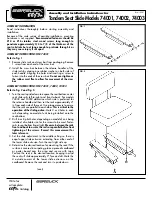
Access Power Solutions Installation Guide (APS3-400 Series)
16
Copyright © 2007-2010 Eaton Corporation. All Rights Reserved.
IPN 997-00012-52D July 2010
Step 4 - Check ac discrimination
Each rectifier has two internal fast-acting fuses. Under certain internal fault
conditions these fuses will blow.
If there is insufficient discrimination between these fuses and an upstream ac
supply-disconnect device supplying the APS then the ac supply to all rectifiers will
be disconnected if a rectifier fuse blows.
1
Check the time-current (tripping) curve(s) of all ac supply-disconnect device(s)
upstream of the APS with the following curve for the rectifier fuses.
Refer to the manufacturer's data for tripping curves.
2
No action is required if the time-current curves of the upstream ac supply-
disconnect devices are entirely to the right of the curves for the rectifier fuses.
3
If the curve of an upstream ac supply-disconnect device crosses the curve for the
rectifier fuse there may not be adequate discrimination. Contact your Eaton dc
product supplier for advice (see Worldwide Support on page
There is a maximum rating for the first upstream circuit breaker(s). See Step 3.
Time-Current Curve (minimum
and maximum)
"
Rectifier internal fuses (IEC
60127-2)
#
50A ac supplementary protector (if
fitted).
Sources:
Schurter SP 5x20 Pigtail data
sheet.
Chint 2005075EN0608 p7, AC
Operation C curve.
Step 5 - Check the grounding arrangements at the site
Confirm that all grounds are brought together at one "star" point so that surge
currents cannot flow in "ground loops" and create large voltages.
Procedure complete
















































